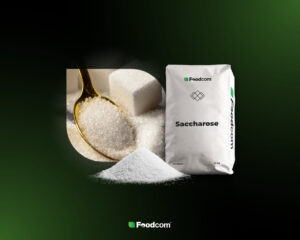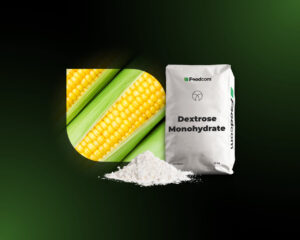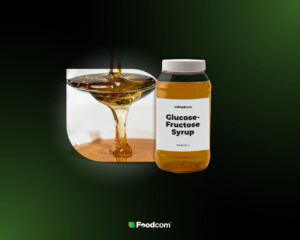- Sugars are a group of chemical compounds, belonging to the carbohydrate family.
- They are divided into: monosaccharides, disaccharides, oligosaccharides and polysaccharides.
- Sugars play a key role as an energy substrate. – They are used not only in the food industry, but also in the pharmaceutical and feed industries.
Sugars are organic compounds found mainly in plants and characterized by a sweet taste. They are also known as carbohydrates, saccharides or sucrose, and form the basis of the daily human diet. Discover what simple sugars are. Find out how you can benefit from using sugars in your business.
Sugars basic classification
Sugars are generally divided into four categories:
Simple sugars – monosaccharide
They consist of a single molecule (monomer) that the body can use for energy immediately after consumption. Monosaccharides such as glucose, fructose, and galactose can add flavor to foods, but they do not provide any essential nutrients like vitamins or minerals.
Disaccharides
Disaccharides are sugars whose molecules are split by hydrolysis to form two monosaccharide molecules. In this category we find, among others, sucrose, lactose, and maltose.
Oligosaccharides
Oligosaccharides are short carbohydrate chains that contain 2 to 10 monomers. They are produced by linking multiple molecules of simple sugars through an O-glycosidic bond. Oligosaccharides have a variety of functions in living organisms. They create the microflora of the intestine and increase the activity of lactobacilli and bifidobacteria, which are essential for digestion.
Oligosaccharides are important for cell and tissue structure, and also help produce hormones, enzymes, and other vital substances.
They are also involved in the mechanisms of hematopoiesis and determine the AB0 blood group. Oligosaccharides play an important role in protecting the body by being present in synovial fluid and having cell walls composed of the right materials. They also help to keep blood vessels elastic.
Complex sugars – polysaccharides
Complex sugars are multi molecular compounds consisting of simple sugars linked together in chains. Complex carbohydrates are broken down into smaller molecules during digestion, which are then released into the blood. Complex sugars include:
- Starch – the reserve sugar of plants, it does not dissolve in cold water or organic solvents. When hot water is added, the starch begins to swell and forms structure of glue. It is found in the form of both amylose and amylopectin;
- Glycogen – the main polysaccharide that comprises the reserve material in animal organisms. It accumulates in the liver and in striated muscle tissues;
- Cellulose – a building block of cell walls of higher plants; it is a component of fibers;
- Hyaluronic acid – the main component of synovial fluid and binds water in the dermis (leather skin).
How does sugar affect your body?
Carbohydrates in food are the most important energy substrate for humans. In a daily diet, they should provide 50-70 percent of energy. They are also a product of photosynthesis as plants synthesize them from carbon dioxide and water. Carbohydrates consist of at least several carboxyl groups and one carbonyl group minimum.
The functions of carbohydrates in living organisms include:
- provision of energy needed for brain function, nutrients,
- building up energy reserves (in humans in the form of glycogen),
- component of DNA and RNA,
- inhibition of blood clotting,
- participation in building cell structures,
- protection of body proteins,
- degradation of fatty acids,
- protection of the body from overproduction of ketone bodies and hyperacidity,
- nutrition of the brain, spinal cord and red blood cells (glucose),
- participation in the mechanism of cell recognition by lymphocytes.
Range of sugars offered by Foodcom
Dextrose Monohydrate
Dextrose monohydrate, also known as d-glucose, is a naturally occurring monosaccharide found in plants and fruits. In the food industry, dextrose is used to obtain desired physical properties of the final product. It improves viscosity, increases sweetness, and serves as a flavor enhancer. The commodity has a weaker sweetening power than other sugars such as sucrose, but it has the higher water solubility rate.
In the feed industry, dextrose monohydrate is used as a nutritional supplement and energy source in various forage mixes. It also enhances the flavor and palatability of the final product.
Dextrose injections are used when a patient with medical problems cannot consume enough fluid or when extra fluid is needed to provide calories from sugar in a short time.
Maltodextrin
Maltodextrin is produced through enzymatic hydrolysis of starch from plants, most commonly from corn but also from rice and wheat. The final product is a loose, white powder of a high solubility rate.
Maltodextrin is a low-cost alternative to other carbohydrates that can be used to provide energy to animals like weaning pigs and lactating cows.
Maltodextrin is used in the food industry for its ability to alter properties like texture and flavor. It ensures the smoothness in canned food items and improves texture in goods such as meats, baked goods, and confectionery. It also acts as an emulsifier.
Glucose
Glucose is the major monosaccharide found in blood. The blood glucose reading is often referred to simply as ‘blood sugar.’ Its value results from the breakdown of carbohydrates ingested with food and the conversion of glycogen to glucose in the liver.
Glucose levels testing plays a major role in the diagnosis and monitoring of diabetes. In type 2 diabetes, high blood sugar levels can lead to disorders of the circulatory, nervous and immune systems.
Glucose is an important source of energy that keeps the cells of the human body active. The breakdown of glucose for metabolism occurs through the conversion of glucose to energy in the target cell.
Glucose syrup
Glucose syrup is a solution consisting of glucose and maltose (simple sugars) and low molecular weight polysaccharides. Glucose syrup occurs in its natural form in fruits (e.g., grapes) or honey. It can also be found in artificially processed foods, providing them with a sweet taste.
Very often glucose syrup is confused with glucose-fructose syrup. But consumption of these syrups has different effects, and that means different health properties. When added to soft drinks, it enhances their refreshing effect and keeps them fresh longer.
Fructose
Fructose occurs in many plants where it is frequently bound to glucose to form the disaccharide sucrose. Small amounts are also found in vegetables. The main sources of fructose in the daily diet are sugar (sucrose) and fructose syrups: corn and glucose-fructose. Fructose metabolism occurs without insulin.
In the food industry, fructose is used as a sweetener and preservative. Due to its hygroscopic property, it is useful in extending the shelf life of bakery products. It gives ice cream its smooth texture. People with diabetes often replace sugar for fructose.
In the pharmaceutical industry, it is used as a substrate. Their popularity is mainly due to being cheaper than sugar. In addition, they have better sensory properties, andood manufacturers apply them in jams, carbonated, and non-carbonated beverages. Fructose-containing foods provide a quick energy boost.
Are you interested in learning more about sugars? Our Foodcom team of Sales Support and Traders is here to advise you on exploring the possibilities of using sugars to expand your portfolio of foodstuffs and feed products. Fill out the contact form!







